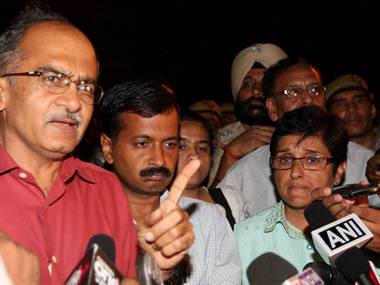“The (Karnataka) Lokayukta has been without a head since September after former Supreme Court judge Shivraj Patil stepped down within a month of taking charge after allegations that he had violated norms to get land allotment… The search for Patil’s successor has made little headway following a stand-off between Karnataka Governor HR Bhardwaj and the state’s Bharatiya Janata Party (BJP) government over the choice of the candidate,” says Mint. “Allegations of corruption have also been levelled against the Lokayukta body itself. Former Lokayukta SP Madhukar Shetty, in an interview to the Kannada newspaper Kannada Prabha earlier this month, alleged that there was considerable corruption within the institution,” the Mint article continues. [caption id=“attachment_143663” align=“alignleft” width=“380” caption=“Civil Society members Prashant Bhushan,Arvind Kejriwal and Kiran Bedi. PTI”]  [/caption] So the search for one individual, the Karnataka Lokayukta, continues for almost two months. Meanwhile, Team Anna is arguing vehemently against, amongst other aspects, the exclusion of Group C and Group D employees, the ‘lower’ bureaucracy. How many of them are there in the country? How many in the ‘higher’ bureaucracy? “Some people say that there is hardly any scope for corruption at the level of Group C and Group D employees. This is incorrect. Inspectors who are infamous for indulging in corruption are Group C employees. It is the Group D staff which is notorious for stealing the critical files from government organisations,” says Team Anna. Team Anna also points out that out of 60,00,000 government employees, Group C and D employees account for 57,00,000,” Firstpost had reported . Some simple math makes the scale of the problem clear. If, on the average, only 10 percent of the bureaucracy is corrupt, (that’s 6,00,000 individuals) and if each employee is guilty of one corrupt act per working day, that’s 6,00,000 complaints that the Lokpal’s office will have to deal with – daily. Imagine that it takes an intelligent Lokpal employee 30 minutes to understand and deal with each complaint, and that the office works eight hours per day, each ‘investigator’ can dispose of 16 complaints per day. That means the Lokpal needs an army of 6,00,000/16 = 37,500 people. That’s the minimum required – with all the completely optimistic assumptions made. If the number of corrupt rises a bit we need more people. If the number of corrupt acts is more than one act per day we need more people. If the Lokpal employees take more than 30 minutes to dispose of a case we need more people. And we cannot find a Lokayukta for Karnataka. One person.
The search for one individual, the Karnataka Lokayukta, continues for almost two months.
Anant Rangaswami was, until recently, the editor of Campaign India magazine, of which Anant was also the founding editor. Campaign India is now arguably India's most respected publication in the advertising and media space. Anant has over 20 years experience in media and advertising. He began in Madras, for STAR TV, moving on as Regional Manager, South for Sony’s SET and finally as Chief Manager at BCCL’s Times Television and Times FM. He then moved to advertising, rising to the post of Associate Vice President at TBWA India. Anant then made the leap into journalism, taking over as editor of what is now Campaign India's competitive publication, Impact. Anant teaches regularly and is a prolific blogger and author of Watching from the sidelines. see more


)

)
)
)
)
)
)
)
)



